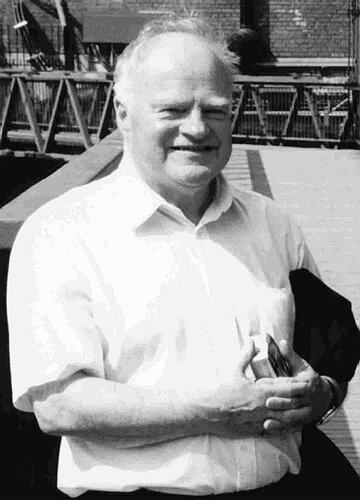Obituary from Transactions, Series III, LXXXII, p152
Duncan Adamson was born in Dumfries to a well known family. After education at Dumfries Academy and the University of Edinburgh, where he was a near contemporary of the writer, he entered the teaching profession in Hamilton, before moving to Bo’ness Academy and then Linlithgow Academy, where he was Principal Teacher of History from 1965 to 1973. In 1973 he returned to home territory as Principal Teacher of History at Dumfries Academy where he was notably successful in presenting large numbers of pupils for the Certificate of Sixth Year Studies. While at Dumfries Academy he served for a number of years as Secretary of the Dumfriesshire History Teachers' Group.
After taking early retirement from teaching in 1986 he embarked on another career in historical and family research.
Duncan had many interests including cricket, football and bridge. He was a member of Loreburn Bridge Club, of which he was a very active President, and he was very well known in Scottish Bridge circles as an outstanding player. At Dumfries Academy he founded a bridge club, which has produced fine players, some of whom are now playing for Scotland. A faithful member of the Church, Duncan served as an elder at Maxwelltown West Church for many years.
Duncan joined D.G.N.H.A.S. in 1972, served as Assistant Secretary to his wife Eva from 1974 to 1979, as Minute Secretary from 1982 to 1983 and as President from 12th October 1983 to 10th October 1986. This bare record of offices held does not do justice to his remarkable range of work for the Society, arising especially out of his abiding passion for historical research. While in Linlithgow he investigated the hearth tax records in West Lothian, later published by the Scottish Records Society, and this was followed by three admirable articles in our own Transactions on the Hearth Tax in Dumfriesshire and parts of Galloway, which were prepared while he still lived in Linlithgow. These articles revealed much about the local population in the 1690s, especially after his expert analysis of the information provided. Another article on the dismissal in 1697 of John Fraser, Rector of Dumfries Grammar School, suggested that he was the victim of sectarian machinations after the Presbyterian Church was established under William and Mary. Other articles included a review of Magnus Magnussons' booklet on King Hakon of Norway, the history of ‘Hastie and Brodie’s’, the Hill family of Cummertrees and some local teind lists from 1619 and 1620.
Duncan spoke to Society meetings on such subjects as Dumfries during the reign of William of Orange and the Parish of Kirkpatrick Fleming, while his Presidential Address in October 1996 was on ‘A Loreburn.’
A major part of Duncan's work arose from the generous Ann Hill bequest to our Society for research into the History and archaeology of Kirkpatrick Fleming Parish. He was appointed the historian for the project. He immediately began to interview many local people so that their memories could be recorded, and also collected many photographs which were duly copied and returned. His researches took him to many archives both local such as Springkell and Raehills, and national including the Register of Sasines, wills and testaments as well as court and church records. This work produced a vast archive, and also various articles in the Transactions with the accompanying off-print booklets, on Ann Hill, the Kirkpatrick Fleming Poorhouse, relevant abstracts from the records of Middlebie Presbytery, the Mossknow Game Register and the diary of a Graham of Mossknow. His work for the Ann Hill bequest led to his appointment as Honorary Archivist to the Earl of Annandale at Raehills.
Although illness prevented the production of a popular local history of Kirkpatrick Fleming by Duncan, his daughter Sheila is writing what promises to be an excellent popular history making full use of her father’s research work. His large archive of parish history will be a source of great value for historians and researchers in the future.
Duncan also contributed significantly on the hearth tax and the poll tax in Scottish Population History edited by Michael Flinn and published by Cambridge University Press in 1977.
Duncan will be remembered as an extrovert enthusiast with an enduring passion for local and national history. His continuing good humour, courage and cheerfulness during his last illness provided an example to us all, and he was even working on indexing his researches the day before he died. He is survived by his wife Eve, two sons and one daughter.
John H D Gair
Bibliography
Publications in the Transactions
Hearth Tax for Dumfriesshire, Part I, II/47/147
Hearth Tax for Dumfriesshire, Part II, III/48/l33
Hearth Tax for Dumfriesshire, Part III, III/49/56
Why they Sacked John Fraser, IIl/55/86
‘Hakon the Old — Hakon Who?' (M.Magnusson. Largs & District Historical Society) A Review, III/57/97
Ann Hill — An Appreciation, III/6l/1
Kirkpatrick Fleming Poorhouse, III/61/103
The History of the Old House or Hastie and Brodie’s, III/62/90
Mossknowe Game Register (co-author with I S Macdonald), III/62/97
Diary of J. Gordon Graham (co-author with I S Macdonald), II/62/101
Kirkpatrick Fleming and the Records of Middlebie Presbytery 1699–1743, III/63/48
Hills in Cummertrees III/63/90
Some Early Teind Lists. NAS Vol. CS 7 335, III/74/95
Publications elsewhere:
‘West Lothian Hearth Tax 1691, with county abstracts for Scotland’, Scottish Record Society, New Series, Vol. 9, 1981.
Scottish Population from the l7th Century to the 1930s ed. Michael Flinn, Cambridge University Press, 1977.

